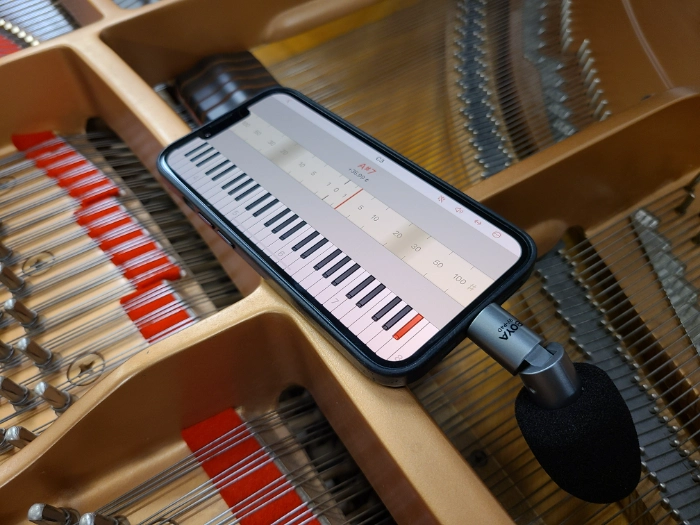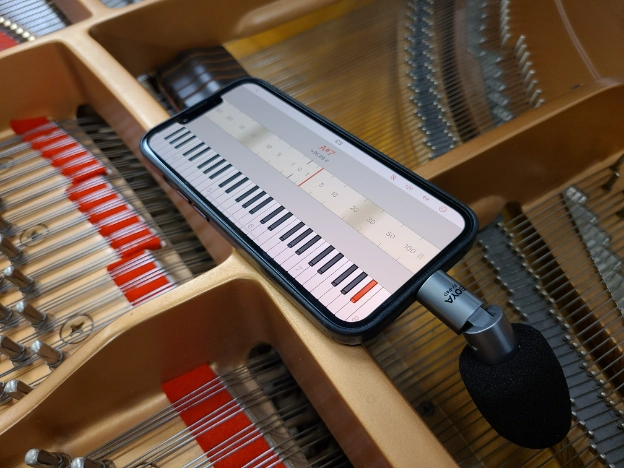Piano Tuner Mic: Microphone Review for Tuning Apps on iPhone

Disclosure: Some of the links in this article may be affiliate links, which can provide compensation to me at no cost to you if you decide to purchase.
What's a good external microphone for piano tuning?
As professional piano tuners we are always looking for better basic tuning functionality, particularly for an electronic tuning aid on a smart phone.
After being inconvenienced enough times with unstable visual feedback from my iPhone's mic, I decided to try out the inexpensive Miniature Omnidirectional Microphone by BOYA.
I found that depending on the tuning circumstance, attaching the external microphone will provide accurate tuner readings vs. poor iPhone mic readings & vice versa.
I will switch between the internal mic and external BOYA mic depending on the quality of the pitch display.
This added piece of equipment is a simple way that I have improved my experience with ETD's for the tuning of pianos.
TLDR;
The absolute best microphone for tuning Pianos is Piano Sens
What are the Pros of the BOYA External Mic?
High end treble and low bass provide reliable/steady & improved readings
Background noise/interference is eliminated for noisy environments
Microphone can tilt toward the reference note
Mic be instantly removed and reconnected
First time setup is "plug & play"
What are the Cons of the BOYA External Mic?
The internal iPhone mic performs better in the midrange (G4 - G6)
The BOYA external mic takes an extra few seconds to switch readings between each of the lowest bass notes of the chromatic tuner
The BOYA external mic must be pointed/oriented correctly (similar to a regular iPhone’s mic)
How to use the BOYA Miniature Omnidirectional Mic?
1. Connect the microphone to your electronic tuning device.
2. Tilt the microphone towards the single note strings you want to measure.
3. Use your tuning device to start tuning.
The BOYA microphone is truly plug and play.
I didn’t have to adjust any settings of any kind. I opened it from the box and began to use it.
Kevin's Recommendation: Attach & detach as you go along the entire piano based on the quality readings of either the internal iPhone mic or the external BOYA mic.
The microphone is pointed towards the high treble strings that are being tuned to measure with high precision.
It’s useful to have another mic to have in my tool kit.
A drawback is that it’s still required to position it correctly to measure the pitch of the string. So, you'll still have to move the mic around to hear it best.
An advantage is that I don’t have to be careful about where I place the device in the high treble to read/measure the pitch of the strings.
Electronic tuning device with BOYA external mic pointed at strings being tuned.
There is noticeably less noise and more signal when it comes to tuning the high treble, which is why I don't worry about placement.
I no longer feel ambivalent about whether I’ll get a good reading or not, which is a relief for once.
While readings in the high treble may still “jump around,” it reliably measures for the intended note.
PianoScope states that, “An external microphone is not necessary to achieve a good tuning quality. However, in extremely noisy environments, an external contact microphone can help avoid interferences.”
While it’s not a Contact Mic, the BOYA microphone for iPhone eliminates interference from background noise. The necessity of being pointed correctly prevents uninvited noise from carrying a reading on the electronic tuning device.
Admittedly, the iPhone microphone does a great job for most of the tuning. Additionally, it may exceed the performance of the BOYA mic particularly in the mid-range of the piano. (Which is when I disconnect the BOYA mic)
In the extremities of the piano, pointing the BOYA mic towards whichever string is being tested, will result in a more confident reading than the internal iPhone mic.
As for noisy environments, I have not yet noticed an interruption in tunings due to external sounds. It’s as if I had forgotten about extraneous noises!
Moreover, I like the option to plug it in and unplug depending on the accuracy of the reading that I’m getting with the tuning device.
This convenience allows for flexibility in case I believe I will get a better reading from an iPhone mic and vice versa.
It feels great to be able to position the microphone (directionally speaking) so that it captures the bass tones accurately.
Once finding the correct position, it is remarkably stable and without ambivalence as to where the pitch is.
Although, sometimes it takes a few moments before the microphone begins to measure the lowest note, as well as the lowest strings of the bass section.
Oddly, the microphone may become confused when reading notes in the midrange, more so than in the extremities.
When I say “confused,” I mean that it will read a nearby fourth, fifth, or octave of the adjacent tones due to activated partials when playing a single note.
In this case, I will simply unplug the BOYA microphone in the mid-range because the iPhone microphone will make a better reading for this particular range of the piano.
This is how the BOYA Miniature Omnidirectional Microphone came in the packaging.
Silica gel beads accompanies the package to prevent any excess moisture during shipment.
They’ve included BOYA bumper stickers as well!
Related:
Expensive Cybertuner App: Get Started with iRCT Tuning
Technician Gear, Tools, Machinery
Best SwissGear Work Backpack Tool Bag Review
Nova Voyager DVR Dril Press Review By A Piano Technician
Best Roll Up Screwdriver Set PB Swiss Tools
Best Piano Service Supplies For Hybrid And Electronic Repair
Best Tools To Use For The Piano Life Saver Dampp Chaser System
Disclosure: Some of the links in this article may be affiliate links, which can provide compensation to me at no cost to you if you decide to purchase.









